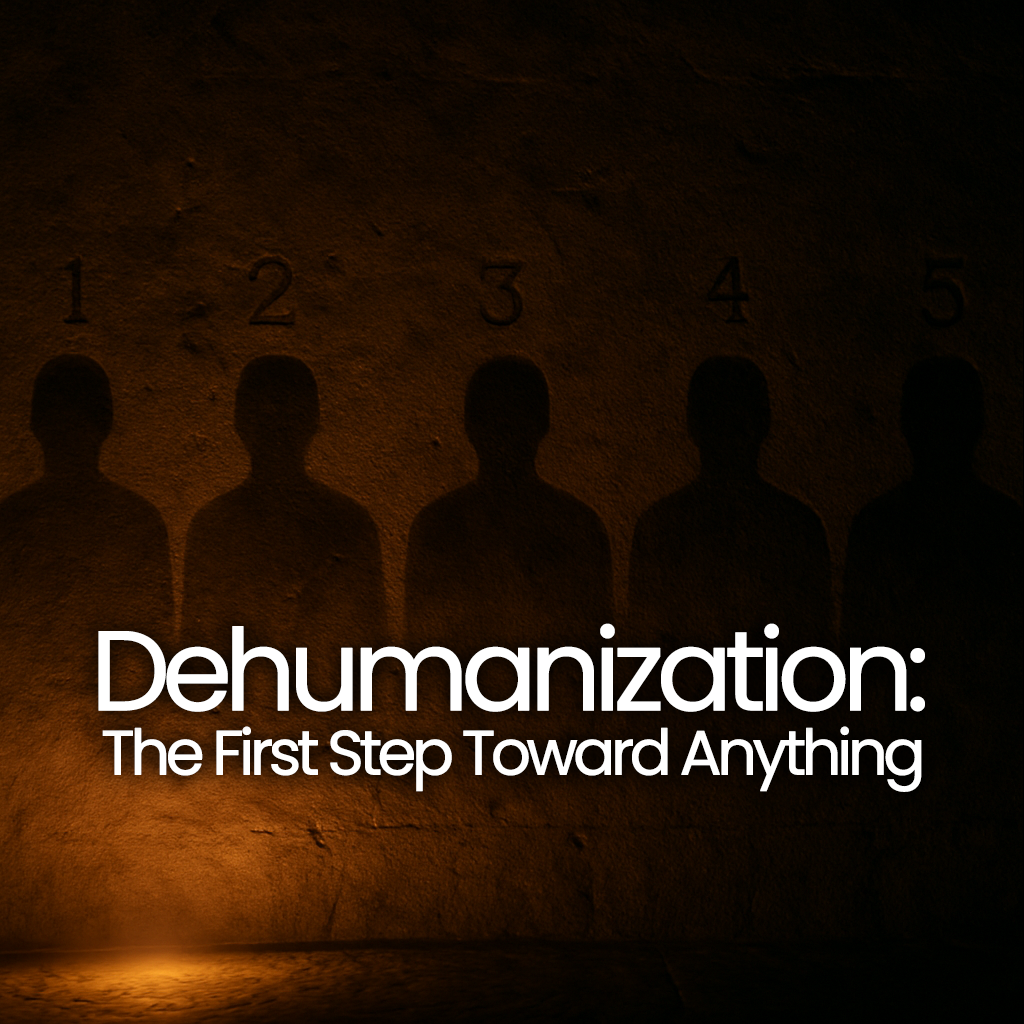Cruelty rarely begins with violence.
It begins with something smaller.
A word, a gesture, a silence.
Before history’s worst atrocities, there were metaphors.
“Pests.”
“Parasites.”
“Animals.”
Each word a rehearsal for what would follow.
This is the unsettling reality of dehumanization: it never arrives in its final form. It slips in quietly, reshaping how we see one another until the unthinkable feels inevitable.
The Origins of Dehumanization
The word itself suggests stripping away; the denial of humanity, the reduction of a person to something less. Scholars have studied it across psychology, history, and sociology, but its roots are older than any textbook.
In every era, societies have found ways to divide between “us” and “them.” The language shifts; barbarian, savage, vermin, illegal, but the function remains constant: to mark one group as less than fully human, and therefore less deserving of protection, empathy, or life itself.
Dehumanization has been the silent preface to genocide, slavery, colonization, and war. But it has also operated in subtler ways: in the bureaucratic language of “collateral damage,” in workplaces where employees become “resources,” in classrooms where students become “scores.”
Its origins are not only historical. They are psychological. To harm another person, we must first find a way to imagine them as something else. That imaginative shift is the essence of dehumanization; a shift so quiet, so ordinary, that most of us don’t notice when we participate in it.
The News We Live In
We don’t have to look far to see dehumanization at work today.
In politics, metaphors turn groups into floods, infestations, or threats. In media, entire communities are reduced to statistics. Online, strangers become avatars, targets for rage or ridicule. Even in everyday life, we flatten people into categories: the slow cashier, the noisy neighbor, the difficult colleague.
None of this feels extreme in the moment. But each act rehearses the same logic: some lives matter more, others matter less.
The danger lies in normalization. Once dehumanizing language enters everyday conversation, it feels less like rhetoric and more like reality. From there, exclusion and violence are easier to justify. Systems take over. Distance grows. And responsibility scatters until no one feels guilty, even as harm multiplies.
Recent years have shown how quickly these dynamics can escalate. From immigration debates to conflicts abroad to online harassment campaigns, the script is familiar: language first, systems second, violence third. And each time, people ask: How did we get here?
The answer is rarely sudden. We got there one word, one silence, one shrug at a time.
The Future at Stake
If the origins of dehumanization are ancient, its future may be even more complex.
As technology advances, we risk new forms of distance. Algorithms already categorize people into patterns, scores, risk profiles. AI systems may decide who receives a loan, who gets flagged at a border, who is considered “high risk.” These decisions are not neutral. They carry the same danger of reducing individuals into data points; efficient, but stripped of story.
Polarization deepens the challenge. As societies fracture into echo chambers, the temptation to flatten the “other side” into caricature grows stronger. The less we speak across differences, the easier it becomes to reduce opponents into enemies.
And yet, the future is not predetermined. Just as dehumanization is learned, it can be unlearned. Rehumanization, though fragile, is possible. It begins in the smallest of acts: calling someone by name, listening without rushing to categorize, resisting the comfort of labels.
If dehumanization is efficient, rehumanization is costly. It demands time, patience, and vulnerability. But it is also the only way forward.
Why This Course Now
Dehumanization: The First Step Toward Anything is not a history lecture. It is a guided reflection. Over six segments, we explore how language, systems, violence, and everyday habits strip away humanity, and what it takes to restore it.
This course is not about despair. It is about vigilance. Not about blame, but about presence.
Because the first step toward cruelty is always how we see.
And every day, with every word and every silence, we choose whether to reduce or to recognize.
Why It’s Free
Some subjects are too urgent to place behind a paywall.
Dehumanization is not only an academic concept or a historical lesson; it is a daily reality. We see it in the way language reduces, in the way systems distance, in the way silence permits. To confront it should not depend on what someone can afford.
That is why Dehumanization: The First Step Toward Anything is free for everyone.
This choice isn’t about lowering value. It’s about widening access. The cost of not talking about dehumanization is far greater than the cost of making it available to all. If this course can help someone notice the first crack, interrupt the first silence, or resist the first label, then it has done its work.
You are free to listen.
You are free to share it.
You are free to pass it forward, if you believe it might help someone else.
Because vigilance against dehumanization is not a product.
It is a practice we owe one another.

Dehumanization: The First Step Toward Anything
What if cruelty didn’t begin with hatred, but with a word?
Dehumanization is not a relic of history.
It is a living habit.
In the way a patient becomes a “case.”
In the way a worker becomes a “resource.”
In the way strangers become “statistics.”
This course does not sensationalize.
It does not offer shock.
It invites attention.



